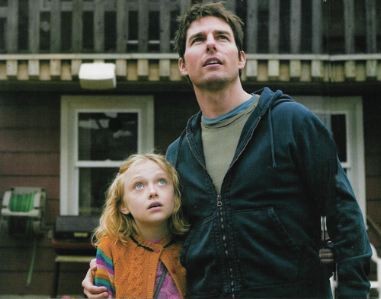War-weary

Steven Spielberg’s War of the Worlds churns up an emulsion of suspense and horror that engulfs you with the gray relentlessness of a low-grade fever. This is not the kind of thrilling, soaring adventure Spielberg created in Jaws or Indiana Jones and the Temple of Doom; it’s a cheerless piece of visceral manipulation. As you watch the extraterrestrial invaders erupting out of the guts of the New Jersey streets, stalking their victims and obliterating them with heat rays, or snatching them off the ground with metallic tentacles and depositing them in nets, sucking them one by one into feeding tubes, the experience can’t exactly be called pleasure. You feel encased by the movie. I can’t remember the last time I felt so relieved to see a picture end.
H. G. Wells’s 1898 novel about Martians seeking to take over the earth is stirring and compact, and so ingenious at the level of basic narrative that it seems adaptation-proof. Orson Welles updated and Americanized it in his notorious 1938 radio broadcast, which used news bulletins to give the story an up-to-the-minute feel. The gripping 1953 movie, with its glorious special effects—now lovingly preserved on DVD—is set in and around Los Angeles, and it preserves Wells’s dark vision by having the attack of the Martians bring out the worst in the terrorized urban dwellers. (In one sequence a truck full of chemicals that might have furnished the scientists with weapons to defeat the assailants is looted by street gangs.)
Spielberg and screenwriters Josh Friedman and David Koepp ground their version in the struggles of a working-class dad (Tom Cruise) to rescue his kids—a sullen, resentful teenage boy (Justin Chatwin) and a sharp-witted and highly sensitive ten-year-old girl (Dakota Fanning). He has been more or less estranged from his children by divorce and his own selfishness. The setting provided by production designer Rick Carter and Spielberg’s favorite cinematographer, Janusz Kaminski, is a grim, ashen, 9/11-inspired landscape that Cruise’s Ray Ferrier and his children have to negotiate like refugees in increasing peril. For most of the picture, the urban Northeast appears metallic and anemic, only in the late scenes acquiring the crimson-soaked look of a deserted battlefield.
Spielberg’s legendary early movies (Jaws, Close Encounters of the Third Kind, E.T.) showed a genius for getting at the comedy of family dynamics, but War of the Worlds contains almost no humor, and the interactions of the Ferrier family aren’t convincing. You can buy Robbie Ferrier’s adolescent fury at his dad, but the way the writers handle his coming of age, in bursts of rebellion, heroism and militant ferocity, is shaky, and then they drop his story altogether, bringing him back at the end for an un-worked-through reconciliation. There’s something cheap about the way the family’s ordeal is set up to provide Ray’s salvation as a father.
Cruise’s movie-star posturings don’t help; he looks more than ever as if he were playing to a mirror. On the other hand, Miranda Otto, as Ray’s ex-wife, manages to suggest the enduring complexity of this fallen marriage by the tone she takes with him—quizzical, affectionate, more woeful than scolding.
What has happened to Spielberg? You can’t fault his staging. His handling of crowd scenes is as staggering as ever. And you can’t fault his editing. Some sequences are marvels of both, like the one in which Ray, little Rachel and a bellicose survivalist (Tim Robbins) whose fate overlaps with theirs hunker down in a cellar, struggling to evade the gaze of a snake-like extraterrestrial probe. But here he displays an unsuspected brutishness. The only moment in the film’s two hours that displays any delicacy is the one where, as Rachel watches in horrified fascination, two aliens spin a bicycle wheel and peruse a photograph.
The rest of the movie is an assault, and the only quality that distinguishes it from other big-budget, high-decibel destruction orgies is Spielberg’s ability to get every effect he goes after. He doesn’t have to rely on explosions and body count, the way a picture like Independence Day does. The best thing you can say about the way this movie draws on the iconography of 9/11 to make a summer entertainment movie is that it displays an unsettling lack of sensibility. The worst you can say is that it’s exploitation of a fairly loathsome order.




